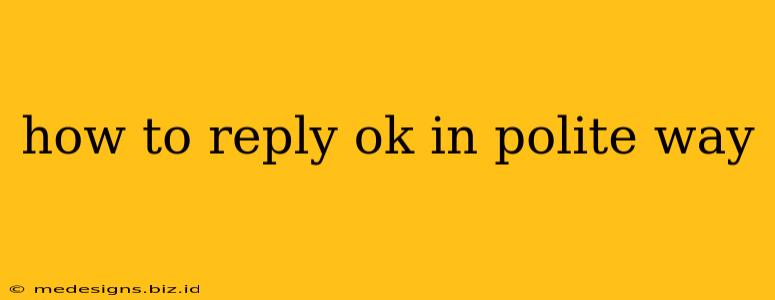How to Reply "OK" in a Polite and Professional Way
Saying "OK" is quick and efficient, but sometimes it lacks the politeness and professionalism needed for certain situations. This guide explores various alternatives, helping you choose the perfect response depending on the context. We'll cover everything from casual conversations to formal emails, ensuring your communication always hits the right note.
Beyond "OK": A Range of Polite Alternatives
The best response depends heavily on context. Here's a breakdown of situations and suitable alternatives to "OK":
Informal Settings (Friends, Family):
- "Sounds good!" This enthusiastic response shows agreement and positive engagement.
- "Great!" or "Perfect!" These convey excitement and approval.
- "Works for me!" Ideal when discussing schedules or plans.
- "Sounds like a plan!" Similar to "Works for me," but slightly more informal.
- "Got it!" A simple, concise, and positive confirmation.
Semi-Formal Settings (Colleagues, Acquaintances):
- "Understood." Clear, concise, and professional.
- "Thank you." Shows appreciation for the information received.
- "I appreciate the update." More formal and shows gratitude for the communication.
- "Will do." Appropriate when responding to a request or instruction.
- "I'll take care of it." Similar to "Will do," but shows more proactive engagement.
Formal Settings (Clients, Superiors):
- "Acknowledged." A formal and respectful confirmation.
- "Thank you for letting me know." Shows politeness and professional courtesy.
- "Please let me know if you need anything else." Offers further assistance and demonstrates willingness to cooperate.
- "I will keep you updated on my progress." Proactive and professional, particularly when responding to requests.
- "I understand and will proceed accordingly." This shows understanding of the instructions and a commitment to follow through.
The Importance of Context in Choosing Your Response
Choosing the right response depends on several factors:
- Your relationship with the person: A casual "Sounds good!" is perfect for a friend, but inappropriate for a client.
- The nature of the communication: A simple "Got it!" suffices for a quick message, while a more formal response is needed for official correspondence.
- The tone of the original message: Mirror the tone of the initial message. If it's formal, maintain formality in your reply.
Avoiding Misunderstandings with Polite Responses
A poorly chosen reply can create misunderstandings. Here’s how to avoid them:
- Be clear and concise: Avoid ambiguity; make your agreement explicit.
- Be respectful: Show consideration for the other person's time and perspective.
- Consider the cultural context: Politeness varies across cultures. Adapt your response accordingly if communicating with someone from a different background.
Mastering the Art of Polite Communication
By carefully selecting your response based on the context, you demonstrate professionalism, respect, and effective communication skills. Remember, a well-chosen alternative to "OK" can significantly impact the tone and effectiveness of your interactions. Practice choosing the most appropriate response and elevate your communication game.
